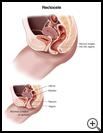
Rectocele
________________________________________________________________________
KEY POINTS
- A rectocele is a bulging of the rectum into the vagina.
- You may feel better with lifestyle changes, exercises, a support device, or surgery.
- Follow the full course of treatment prescribed by your healthcare provider. Ask your provider what symptoms or problems you should watch for and what to do if you have them.
________________________________________________________________________
What is a rectocele?
A rectocele is a bulging of the rectum into the vagina.
What is the cause?
Ligaments, muscles, and connective tissue normally hold your rectum and other organs in their proper places in your lower belly (pelvis). If these tissues get weak, your rectum or other organs may push into the vagina.
Childbirth is the most common cause of a rectocele, especially if you had a large baby or a long or difficult labor. The muscles and skin of the birth canal (vagina) are stretched and sometimes torn during childbirth. The tissues heal over time but may not be as strong as they were before.
Older women may have this problem because the loss of female hormones after menopause weakens the vaginal walls.
Over time, the following may increase your risk of having a rectocele:
- Inherited weak ligaments and muscles
- Chronic coughing
- Chronic constipation
- Frequent heavy lifting
- Frequent straining to pass bowel movements
- Obesity
- Injury to the vagina or pelvic muscles
- Previous pelvic surgery
What are the symptoms?
You may not have any symptoms. If you do have symptoms, they may include:
- A feeling of pressure in the rectal area
- Trouble having bowel movements. In serious cases, you may have to press on the lower part of your vagina to help push the stool out of your rectum.
- Leaking of bowel movements
- Tissue sticking out of the opening of the vagina
- Trouble having sexual intercourse
- Trouble putting a tampon into your vagina
The bladder may also press into the vagina. This problem is called a cystocele. It may cause bladder symptoms. For example, you may keep getting bladder infections or leak urine.
How is it diagnosed?
Your healthcare provider will ask about your symptoms. You will have a pelvic exam. Your provider may ask you to bear down and push as you would to have a bowel movement. This will help your provider see how much the rectocele bulges into the back of the vagina. Your provider may also ask you to squeeze the muscles of your pelvis (as you would to stop urinating) to see how strong they are. You may be examined in different positions: lying down, standing up, and squatting. You will also have a rectal exam. You may have tests of the nerves and muscles of the pelvis and around the rectum.
How is it treated?
Possible treatments include:
- Lifestyle changes: Sometimes the symptoms can be treated with changes in diet, medicine to soften your bowel movements, weight loss, or avoiding strenuous activities.
- Kegel exercises: These are exercises you can do to strengthen the muscles in and around your vagina. When you do Kegel exercises, you squeeze and relax your pelvic muscles as though you were trying to stop a flow of urine. Hold each squeeze for up to 10 seconds, then let go. Try to do 50 squeezes per day.
- Pessary: A pessary is a silicone or plastic device prescribed by your healthcare provider. It’s inserted into the vagina to help support the uterus, bladder, and rectum.
- Surgery: You may need surgery to remove or repair weakened tissue.
How can I take care of myself?
- Try to keep a healthy weight. If you are overweight, lose weight.
- Eat high-fiber foods to help you move your bowels without straining.
- Drink plenty of fluids.
- Strengthen your pelvic muscles by doing Kegel exercises every day. It is especially helpful to do these exercises before and after childbirth.
- Don’t wear tight underwear or clothing that puts pressure on your belly.
- Avoid frequent heavy lifting. When you do lift, bend your knees and hips and keep your back straight.
- If you have a chronic cough, talk to your healthcare provider about treating the cough.
- If you smoke, try to quit.
If you are concerned about the effect of childbirth on your pelvic tissues, discuss this with your healthcare provider before your baby is born.
Follow the full course of treatment prescribed by your healthcare provider. Ask your provider:
- How and when you will get your test results
- How long it will take to recover
- If there are activities you should avoid and when you can return to your normal activities
- How to take care of yourself at home
- What symptoms or problems you should watch for and what to do if you have them
Make sure you know when you should come back for a checkup. Keep all appointments for provider visits or tests.

